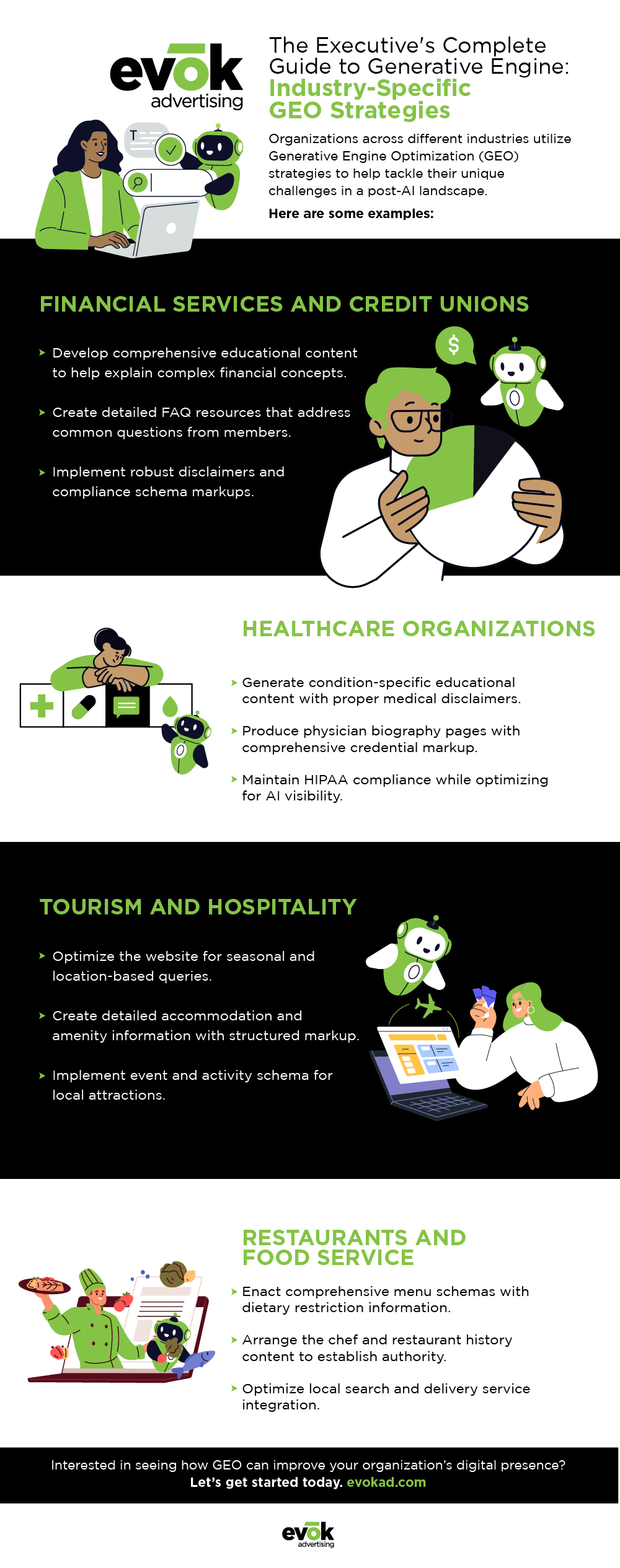
The Executive’s Complete Guide to Generative Engine Optimization: Strategic Planning for the Post-Click Era
The digital marketing landscape has fundamentally shifted. While your organization focuses on traditional SEO metrics (rankings, clicks, and conversions), a parallel universe of search behavior is emerging where users never visit your website but still consume your content. This isn’t a future prediction; it’s happening now across every industry, from financial services to healthcare to hospitality.
Recent industry data reveals that AI Overviews now appear in 13.14% of all Google queries as of March 2025, more than doubling from 6.49% in January 2025. Position 1 click-through rates have dropped by 34.5% when AI Overviews are present, while keywords triggering these features see an average CTR decline of 15.49%.

This guide provides executives with the strategic framework, technical requirements, and implementation roadmap necessary to navigate Generative Engine Optimization (GEO), the practice of optimizing content for citation and reference within AI-generated responses rather than traditional click-through traffic.
Understanding the Fundamental Shift: From Traffic to Authority
The shift from traditional click-driven search to zero-click behavior marks a fundamental change in how users find and interact with information online. Long before AI became widespread, features like Google’s Featured Snippets and Knowledge Panels were already conditioning users to get answers directly on the search results page without needing to click through. The integration of large language models has accelerated this trend dramatically, with AI-generated summaries now covering a vast majority of queries in sectors like healthcare, education, and B2B technology. This evolution challenges conventional metrics, as decreasing website traffic doesn’t necessarily mean your content is underperforming; rather, your content may exert greater influence by appearing in AI-powered overviews.
The Zero-Click Evolution

Zero-click search behavior didn’t begin with AI. Google’s Featured Snippets, Knowledge Panels, and People Also Ask boxes have conditioned users to find answers without clicking for over a decade. However, the integration of large language models into search platforms has accelerated this trend exponentially.
The data tells a clear story. In the healthcare and education sectors, AI Overviews now cover nearly 90% of queries. The B2B technology sector saw coverage jump from 36% to 70% in 2024, while the insurance industry experienced an even steeper rise, from 17% to 63% within just twelve months. Interestingly, e-commerce queries showed a decline in AI Overview coverage. It went from 29% to just 4%, highlighting that transactional intent still favors traditional search behavior.
Why Traditional Metrics Miss the Mark
The most dangerous assumption executives make is equating decreased website traffic with diminished content performance. In reality, your content may be performing better than ever; it’s just invisible to your analytics.
When Google’s Gemini or other AI platforms synthesize your content into above-the-fold summaries, several things happen:
- Users receive immediate value without clicking.
- Your content influences their decision-making process.
- Your brand gains implicit authority and trust.
- None of this appears in your traffic reports.
This creates what we call the “Authority Paradox”, as while your content’s influence grows, traditional success metrics decline.
The Business Case for GEO Implementation

Implementing a Generative Engine Optimization (GEO) strategy offers businesses a powerful opportunity to gain a competitive edge in the rapidly evolving landscape of AI-driven search. Early adopters are already reaping strategic benefits such as enhanced brand authority, sustained relevance through future-proof content, and greater visibility across multiple AI platforms. These advantages set forward-thinking organizations apart from competitors who still rely solely on traditional SEO approaches. However, successful GEO implementation requires thoughtful investment across content development, technical infrastructure, and specialized monitoring tools—each essential to building a robust foundation that drives measurable return on investment and long-term growth.
Strategic Advantages of Early Adoption
Organizations implementing GEO strategies report several key competitive advantages that are pivotal in allowing tech-savvy businesses to prosper. These advantages include, but aren’t limited to:
Enhanced Brand Authority: Companies appearing regularly in AI-generated responses experience increased brand recognition and trust, even without direct website visits.
Future-Proof Content Strategy: As search behavior continues evolving toward conversational and voice-driven queries, GEO-optimized content maintains relevance across platforms.
Competitive Differentiation: With most organizations still focused exclusively on traditional SEO, early GEO adopters gain significant visibility advantages in AI-driven search results.
Cross-Platform Visibility: GEO principles apply across multiple AI platforms—from Google’s AI Overviews to ChatGPT, Perplexity, and emerging generative search engines.
Investment Requirements and ROI Considerations
Effective GEO implementation can’t be achieved without establishing a sound foundation. This requires strategic budget allocation across three primary areas:
Content Development (40-50% of GEO budget): Creating comprehensive, authoritative content that serves as reliable source material for AI platforms requires significant editorial investment. Unlike traditional SEO content, GEO-optimized material must demonstrate clear expertise, provide citation-worthy facts, and maintain accuracy at scale.
Technical Infrastructure (30-40% of GEO budget): Implementing structured data, schema markup, and content architecture that enables AI platforms to efficiently parse and understand your content requires technical expertise and ongoing maintenance.
Monitoring and Analysis (10-20% of GEO budget): Tracking brand mentions, content citations, and visibility across AI platforms requires specialized tools and analytics capabilities beyond traditional SEO measurement.
The GEO Implementation Framework: A Technical Roadmap
Implementing a successful Generative Engine Optimization (GEO) strategy demands a foundational shift in how organizations structure, create, and distribute content for AI-driven platforms. As search behavior evolves and AI engines prioritize structured, authoritative, and conversational information, organizations must build GEO strategies rooted in both technical precision and content depth. This process unfolds across four critical phases: infrastructure assessment, content transformation, technical implementation, and ongoing monitoring and optimization. Each phase plays a distinct role in ensuring content is discovered by generative engines and trusted, cited, and surfaced ahead of competitors.
Phase 1: Infrastructure Assessment and Preparation
Content Architecture Audit: Organizations must evaluate their existing content infrastructure before optimizing for AI consumption. This involves analyzing:
- Content depth and comprehensiveness across key topic areas.
- Technical implementation of structured data and schema markup.
- Page loading speeds and mobile optimization (AI platforms prioritize fast-loading, accessible content).
- Internal linking architecture and topic clustering.
Entity Optimization Foundation: AI platforms excel at understanding entities (people, places, organizations, and concepts) and their relationships. Successful GEO implementation requires:
- Consistent entity markup across all content.
- Clear organizational schema implementation.
- Comprehensive “About” pages with detailed entity information.
- Strategic internal linking that reinforces entity relationships.
Phase 2: Content Strategy Transformation
Question-Driven Content Development Traditional keyword-focused content often fails in GEO contexts because AI platforms prioritize comprehensive answers over keyword density. An effective GEO content strategy involves:
- Natural Language Query Optimization: Creating content that directly answers how users ask questions, not just how they search.
- Comprehensive Topic Coverage: Developing content clusters that address entire subject areas rather than individual keywords.
- Expert-Level Detail: Providing depth and specificity that positions your content as an authoritative source.
Format Optimization for AI Consumption: AI platforms favor content with a clear structure and semantic meaning. This requires:
- Strategic use of header hierarchies (H1, H2, H3) that create logical content flow.
- Implementation of FAQ schemas and structured question-answer formats.
- Use of lists, tables, and other organized data formats that AI can easily parse.
- Integration of relevant statistics, dates, and factual information that enhances credibility.
Phase 3: Technical Implementation
Advanced Schema Markup Strategy: While basic schema markup has been SEO best practice for years, GEO requires more sophisticated implementation:
- Organization Schema: Comprehensive markup identifying your business, leadership, expertise areas, and industry authority
- Article Schema: Detailed content markup including author information, publication dates, and topic categorization
- FAQ Schema: Structured question-answer pairs that align with common user queries
- How-To Schema: Step-by-step process markup for procedural content
Content Distribution Architecture: GEO success often depends on content appearing across multiple authoritative sources. This requires:
- Strategic content syndication to industry publications and authoritative third-party sites.
- Consistent NAP (Name, Address, Phone) information across all platforms.
- Active participation in industry forums, publications, and thought leadership opportunities.
- Development of quotable, citation-worthy insights that other publications reference.
Phase 4: Monitoring and Optimization
GEO Performance Measurement: Traditional SEO metrics provide incomplete pictures of GEO success.
Comprehensive measurement requires:
Brand Mention Tracking: Monitoring your organization’s frequency in AI-generated responses across platforms, including sentiment analysis and context evaluation.
Citation Quality Assessment: Evaluating the authority and relevance of sources referencing your content, as AI platforms weigh citations from high-authority sources more heavily.
Topic Authority Measurement: Tracking your organization’s visibility for key subject areas and expertise domains within AI-generated content.
Competitive Analysis: Understanding how competitors appear in AI responses and identifying content gaps or opportunities for improved positioning.
Industry-Specific GEO Strategies

As GEO strategies mature, it’s clear that a one-size-fits-all approach won’t suffice as each industry faces its own unique challenges, regulatory considerations, and audience expectations. Organizations must tailor their GEO implementations to align with sector-specific demands and content priorities to maximize impact. For example, financial institutions must navigate compliance while building trust through educational resources, while healthcare providers must balance clinical accuracy with patient accessibility, all within HIPAA guidelines. In contrast, travel, hospitality, and food service businesses benefit from emphasizing local discovery, visual storytelling, and structured data to showcase experiences and offerings. This section explores how different industries can craft GEO strategies that meet the technical requirements of AI platforms and resonate deeply with their audiences.
Financial Services and Credit Unions
Financial institutions face unique GEO challenges due to regulatory requirements and the sensitive nature of financial advice. Successful strategies would need to involve careful consideration of how audiences would perceive them. They can be especially important for local credit unions seeking to compete with larger financial institutions with significantly more resources. This can be achieved through:
- Developing comprehensive educational content that explains complex financial concepts.
- Creating detailed FAQ resources addressing common member questions.
- Implementing a robust disclaimer and compliance schema markup.
- Focusing on local optimization for community-based institutions.
Healthcare Organizations
Healthcare providers must balance accessibility with medical accuracy when optimizing for generative engines, ensuring that the content surfaced is both understandable to patients and clinically trustworthy. This is particularly critical as AI platforms increasingly become go-to sources for health information, where misinformation can have serious consequences. Every aspect of a healthcare organization’s GEO strategy must align with HIPAA regulations and other compliance standards, while still meeting the content formats and structures favored by AI systems. Some of the considerations to keep in mind involve:
- Creating condition-specific educational content with proper medical disclaimers
- Developing physician biography pages with comprehensive credential markup
- Implementing service-specific schema for treatments, procedures, and specialties
- Maintaining HIPAA compliance while optimizing for AI visibility
Tourism and Hospitality

Travel and hospitality organizations can leverage GEO for destination marketing and experience promotion. By optimizing content for generative platforms, they can showcase accommodations and local experiences in a more engaging, conversational format. Personalized itineraries can be created with an increased level of personalization. This approach increases visibility during the early planning stages of a traveler’s journey, influencing decisions before a single click. This would entail:
- Developing comprehensive destination guides with local expertise.
- Creating detailed accommodation and amenity information with structured markup.
- Implementing event and activity schema for local attractions.
- Optimizing for seasonal and location-based queries.
Restaurants and Food Service
Food service businesses benefit from GEO through menu optimization and local discovery. Through structuring content around certain specifications (popular dishes, dietary preferences, and location-specific offerings), restaurants can appear more prominently in generative search results. This level of optimization not only drives local discovery but also influences user decisions when they’re seeking dining options, resulting in significant traffic and visibility. The ways this is accomplished are through:
- Implementing a comprehensive menu schema with dietary restriction information.
- Creating detailed cuisine and ingredient descriptions.
- Developing chef and restaurant history content for authority building.
- Optimizing for local search and delivery service integration.
Risk Management and Competitive Considerations
As organizations invest in Generative Engine Optimization (GEO), it’s essential to approach implementation with a clear understanding of the associated risks and competitive dynamics. While GEO offers powerful opportunities for increased visibility and authority, it also introduces challenges related to content accuracy, resource demands, and platform dependency. Additionally, unlike traditional SEO, GEO success metrics are still emerging, requiring new tools and methods for measurement. Beyond operational risks, organizations must also navigate a highly competitive landscape, where small differences in strategy can significantly affect placement in AI-generated results. Proactive risk management and continuous competitive intelligence are critical to sustaining GEO performance over time.
Potential Challenges in GEO Implementation
While GEO presents exciting opportunities for increased visibility in AI-driven search, it also introduces a unique set of implementation challenges that organizations must carefully manage. Maintaining high content quality is essential, as inaccuracies or outdated information can harm both credibility and ranking within AI responses. The ongoing demands of content creation, technical upkeep, and strategic adaptation can strain internal resources and require dedicated investment. Furthermore, as GEO success metrics are still evolving, traditional SEO tools may fall short. Organizations must remain agile in the face of platform dependency, as algorithm shifts or policy changes from major AI providers can impact visibility with little warning.
Content Quality Control: As AI platforms prioritize authoritative sources, any inaccuracies or outdated information can significantly impact visibility and credibility.
Resource Allocation: GEO requires ongoing content development and technical maintenance that may strain existing marketing budgets and personnel.
Measurement Complexity: Unlike traditional SEO, GEO success metrics are evolving and may require new analytics approaches and tools.
Platform Dependency: Heavy reliance on AI platform algorithms creates potential vulnerability to algorithm changes and platform policy modifications.
Competitive Intelligence and Market Positioning
Organizations implementing GEO must consider certain competitive dynamics that may impact how they’re featured in comparison to their competitors. As AI engines often highlight a limited set of responses, even small differences in optimization can significantly impact visibility and user trust. To this end, organizations must:
- Monitor competitor visibility in AI-generated responses.
- Identify content gaps where competitors lack comprehensive coverage.
- Develop unique expertise areas where your organization can establish thought leadership.
- Create barriers to entry through comprehensive topic coverage and technical implementation.
Implementation Timeline and Resource Planning
Effective GEO implementation requires careful planning, phased execution, and cross-functional coordination to ensure both immediate impact and long-term scalability. A well-structured timeline helps organizations prioritize resources, align teams, and progressively build the technical and content foundations needed for success in AI-driven search environments. This section outlines a 90-day program designed to deliver early wins. It begins with assessment and planning, followed by foundational schema work, priority content development, and a roadmap for continued growth over the following 6 to 12 months. Organizations can steadily enhance their visibility, authority, and competitive positioning by approaching GEO as an ongoing strategic initiative rather than a one-time project.
90-Day Quick Start Program
Days 1-30: Assessment and Planning
- Complete technical infrastructure audit.
- Analyze existing content for GEO optimization opportunities.
- Identify priority topic areas and competitive gaps.
- Develop a content calendar and resource allocation plan.
Days 31-60: Foundation Implementation
- Implement core schema markup and structured data.
- Optimize existing high-performing content for AI consumption.
- Begin development of a comprehensive FAQ and educational content.
- Establish monitoring and measurement protocols.
Days 61-90: Content Development and Optimization
- Launch priority content pieces optimized for GEO.
- Begin strategic content distribution and syndication.
- Implement advanced schema markup for complex content types.
- Analyze initial performance data and adjust strategy.
Long-Term Strategic Development
Months 4-6: Expansion and Refinement
- Develop comprehensive content clusters around key expertise areas.
- Expand technical implementation to cover all relevant schema types.
- Begin industry thought leadership and content syndication initiatives.
- Refine measurement and optimization processes based on performance data.
Months 7-12: Market Leadership and Innovation
- Establish organization as go-to source for industry-specific information.
- Develop proprietary research and data that other sources cite.
- Implement advanced technical optimizations and emerging best practices.
- Scale successful strategies across all content and marketing initiatives.
Technology Stack and Vendor Considerations

A successful GEO strategy relies not only on content and optimization tactics but also on a well-equipped technology stack that supports its execution at scale. Organizations must ensure their content management systems can handle advanced schema markup, structured data, and the flexible architecture needed for entity and topic-based optimization. Equally important are analytics tools beyond traditional web metrics to track brand mentions, citations, and AI platform visibility. To maximize efficiency and impact, GEO tools and workflows should also integrate seamlessly with existing marketing technologies—from CRM and marketing automation platforms to social media and PR tools—enabling cohesive execution across all channels.
Essential Technical Infrastructure
Implementing GEO effectively requires a robust technical foundation to support the evolving demands of AI-driven search. This infrastructure’s core is a capable content management system (CMS) that allows for advanced schema markup, structured data handling, and flexible architecture to support topic clustering and entity-based optimization. In addition, traditional analytics tools must be augmented with capabilities that track brand mentions, citations, and AI visibility to provide a clearer picture of performance. Equipping content teams with research databases, fact-checking tools, and collaborative platforms is also essential to ensure the development of authoritative, accurate, and AI-ready content.
Content Management Requirements: CMS platforms must support comprehensive schema markup implementation, structured data management, and flexible content architecture that enables topic clustering and entity optimization.
Analytics and Monitoring Tools: Traditional web analytics must be supplemented with brand mention tracking, citation analysis, and AI platform visibility monitoring capabilities.
Content Development Tools: Teams require access to research databases, fact-checking resources, and collaboration platforms that support comprehensive content development workflows.
Integration with Existing Marketing Technology
GEO implementation must integrate seamlessly with existing marketing operations. That way, organizations can continue to use the practices that work best with them while also enjoying the benefits that come with GEO. These tools and practices include:
- CRM systems for lead attribution and customer journey tracking.
- Marketing automation platforms for content distribution and nurturing.
- Social media management tools for cross-platform content syndication.
- Public relations and media monitoring tools for thought leadership tracking.
Measuring Success: KPIs and Performance Indicators
Measuring success in Generative Engine Optimization (GEO) requires a shift from traditional SEO metrics to more nuanced indicators that reflect performance within AI-driven ecosystems. Because AI platforms surface content differently than standard search engines, organizations must track how often and how credibly they are referenced in generative responses. Key GEO metrics include brand mention frequency, citation authority, topic coverage, and competitive share of voice—all of which help gauge visibility and influence across platforms. In addition to these primary indicators, secondary metrics such as content engagement, expert recognition, and brand trust provide valuable insight into the broader impact of a GEO strategy on reputation and audience perception.
Primary GEO Metrics
To accurately measure the impact of a GEO strategy, organizations must focus on a set of core performance metrics that reflect how well their content is represented and valued across generative platforms. Primary GEO metrics provide direct insight into visibility, authority, and competitive positioning within AI-generated responses. These include tracking brand mention frequency across different platforms, assessing the quality of citations through a citation authority score, measuring topic coverage to ensure broad representation in key subject areas, and evaluating competitive share of voice to understand how your presence compares to industry peers. Together, these indicators form the foundation for understanding GEO effectiveness.
Brand Mention Frequency: Tracking how often your organization appears in AI-generated responses across different platforms and query types.
Citation Authority Score: Measuring the quality and relevance of sources that reference your content, weighted by platform authority and topic relevance.
Topic Coverage Percentage: Evaluating your organization’s visibility across key subject areas within your industry or expertise domain.
Competitive Share of Voice: Comparing your AI platform visibility to key competitors across priority topics and query types.
Secondary Performance Indicators
Beyond visibility and citation metrics, secondary GEO indicators help assess the broader business and reputational impact of generative search performance. These metrics capture how users engage with surfaced content and how AI visibility translates into real-world authority. This includes analyzing content engagement quality—such as time on page and conversion rates from AI-driven traffic—and tracking expert recognition through speaking opportunities and media mentions. Additionally, brand trust indicators help measure shifts in perception and credibility, offering a more complete view of how GEO efforts influence brand equity over time.
Content Engagement Quality: Analyzing user interaction with content that appears in AI responses, including time spent on referenced pages and conversion rates from AI-driven traffic.
Expert Recognition Metrics: Tracking industry recognition, speaking opportunities, and media citations that result from improved AI platform visibility.
Brand Trust Indicators: Measuring improvements in brand perception, customer trust scores, and industry authority recognition.
Future-Proofing Your GEO Strategy
The GEO landscape is evolving at a rapid pace, driven by continuous advancements in AI technology and shifting user behaviors. To future-proof their strategies, organizations must anticipate and adapt to emerging trends such as multimodal search integration, where voice, image, and video content play an expanding role in AI responses. Additionally, there is a growing emphasis on real-time information synthesis, personalization, and deeper context awareness, enabling AI platforms to deliver highly relevant, user-specific answers. As these platforms become increasingly interconnected, successful GEO strategies will require agility and foresight to maintain visibility across a diverse and evolving ecosystem.
Emerging Trends and Platform Evolution
The GEO landscape continues to evolve rapidly with little signs of stopping. If organizations want to adapt for the future, they must prepare for:
- Multimodal Search Integration: AI platforms increasingly incorporate voice, image, and video content in responses.
- Real-Time Information Synthesis: Growing emphasis on current, time-sensitive information in AI-generated responses.
- Personalization and Context Awareness: AI platforms are developing a more sophisticated understanding of user intent and context.
- Cross-Platform Integration: Increasing interconnection between different AI platforms and search engines.
Building Adaptive Capabilities
A successful long-term GEO strategy requires organizational capabilities adapting to platform changes. Flexibility and cross-functional collaboration are key to maintaining visibility as new platforms and features emerge. This includes:
- Content Agility: Ability to quickly update and optimize content based on platform algorithm changes.
- Technical Flexibility: Infrastructure that can accommodate new schema types and markup requirements.
- Competitive Intelligence: Ongoing monitoring of industry trends and competitor strategies.
- Innovation Culture: Organizational willingness to experiment with new approaches and technologies.
The Strategic Imperative for GEO Adoption

Generative Engine Optimization isn’t limited to being a tactical addition to existing SEO strategies; it’s a fundamental shift in how organizations build authority and influence in digital markets. As AI platforms increasingly mediate the relationship between businesses and their audiences, the ability to appear authoritatively in AI-generated responses becomes essential for competitive survival.
The organizations that thrive in this new environment will recognize GEO not as a replacement for traditional marketing but as an evolution that requires new capabilities, measurement approaches, and strategic thinking. The technical infrastructure, content strategies, and organizational processes outlined in this guide provide the foundation for sustainable competitive advantage in an AI-driven search landscape.
For executives considering GEO implementation, the question is whether your organization will lead or adapt to it. The data clearly shows that early adopters gain significant advantages in brand authority, competitive positioning, and market influence that compound over time.
The post-click era has arrived. Organizations that understand how to build authority and influence without depending on website traffic will define the next decade of digital marketing success. Don’t wait for your competitors to define your presence in AI-driven search. Contact our digital advertising team today.